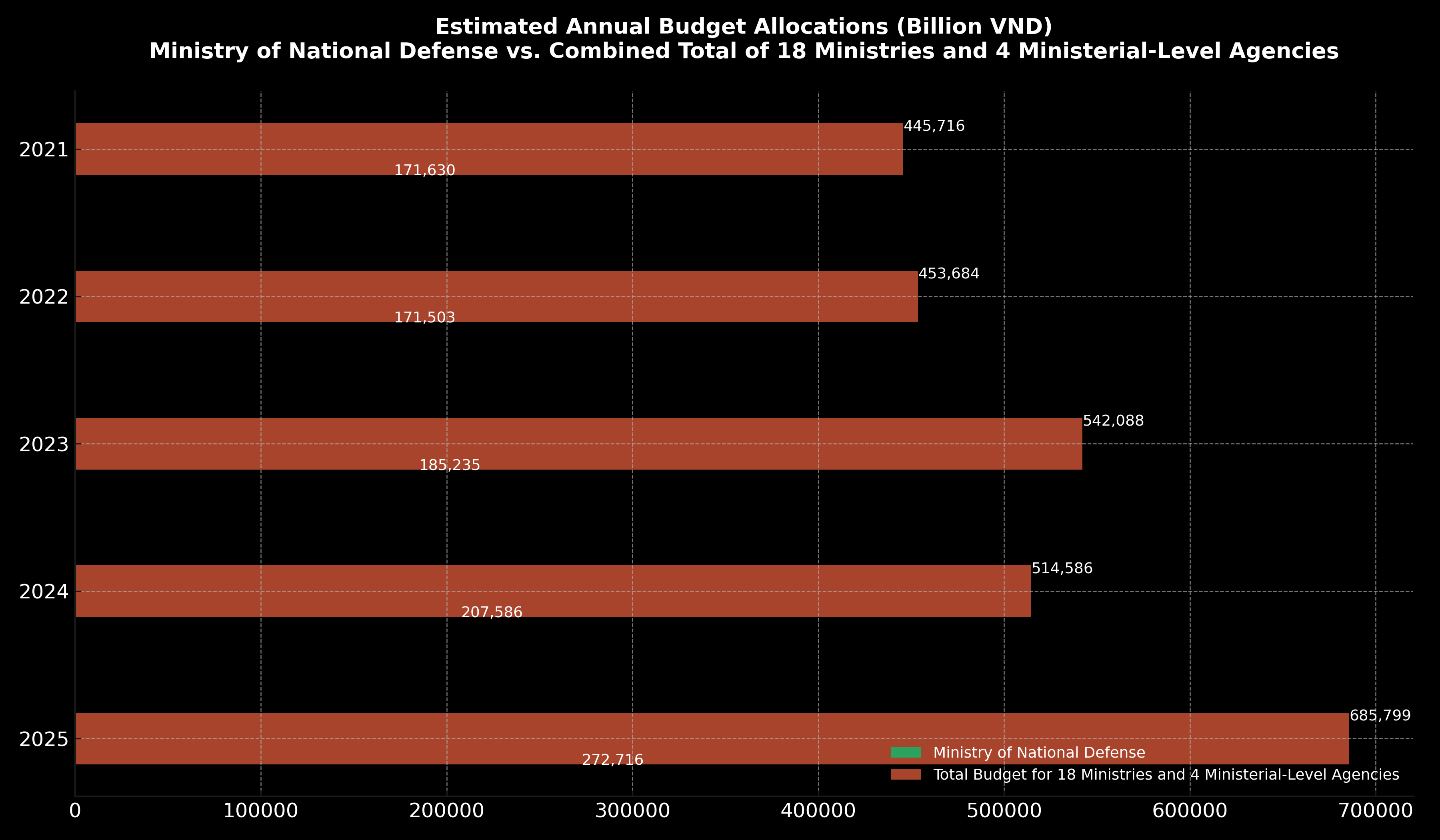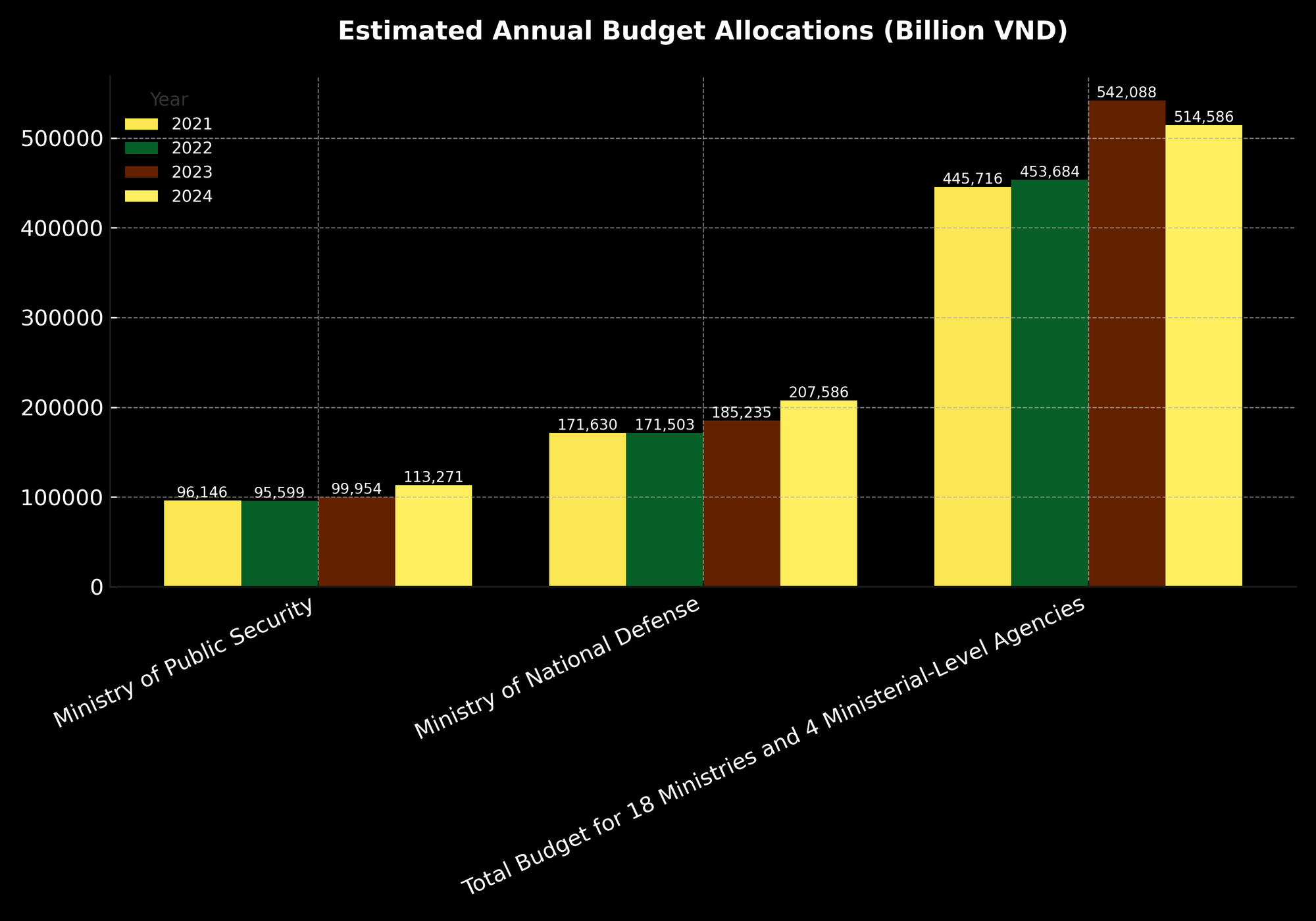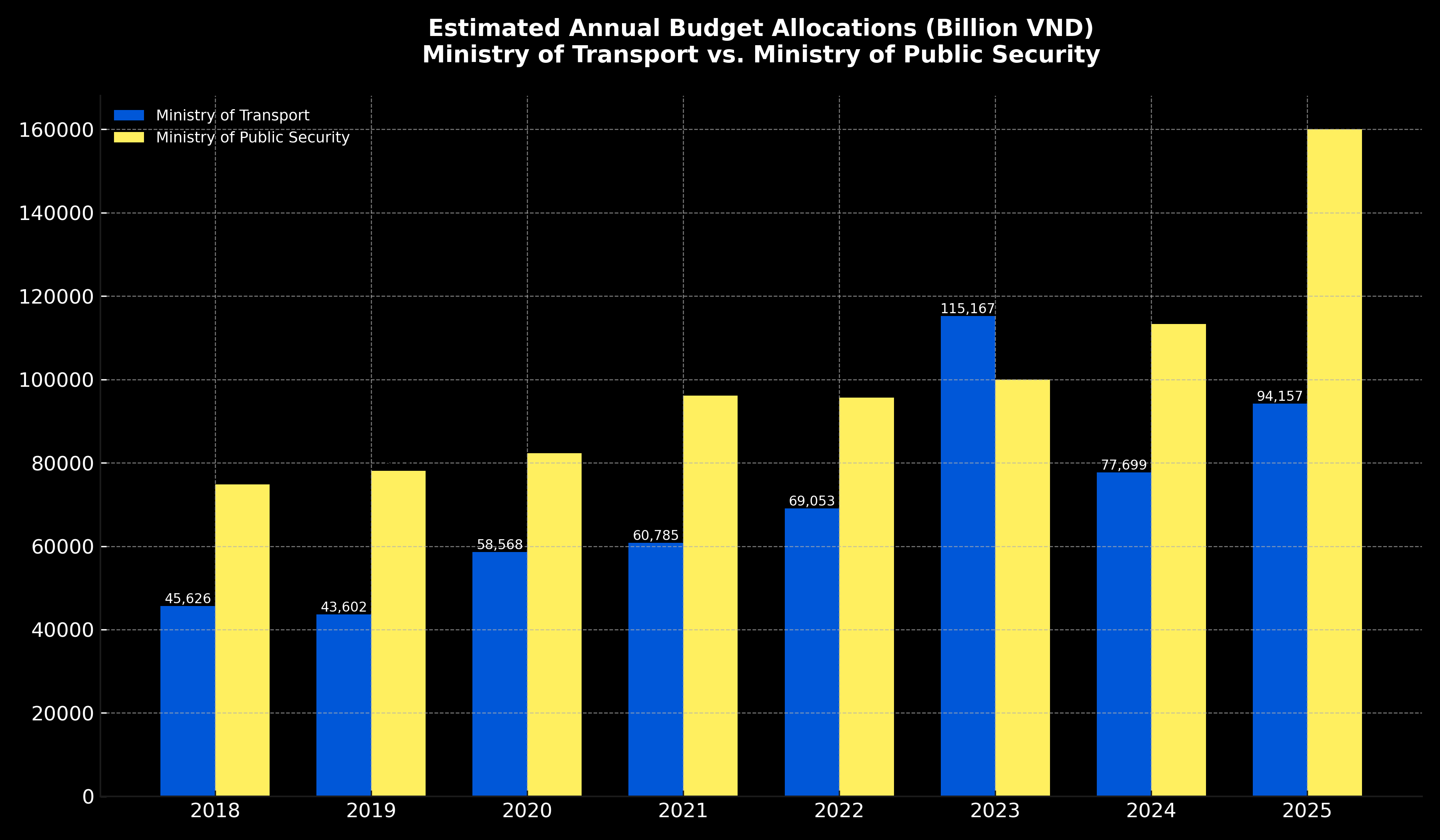Việt Nam Balances Powers as Xi Jinping Courts Hà Nội Amid Tariff Tensions
Key Events * Unspoken Messages Behind Xi Jinping’s Visit to Việt Nam and Meeting with Tô Lâm * Việt Nam Moves
Since 2021, five ministries have received the largest budgets, yet two of them have since been dissolved.

Hiếu Mạnh wrote this Vietnamese article, published in Luật Khoa Magazine on March 25, 2025. Thúc Kháng translated it into English for The Vietnamese Magazine.
Under Decree 123/2016, ministries and ministry-equivalent agencies oversee state management in one or multiple sectors while providing public services nationwide.
Based on the National Assembly’s annual resolutions on central budget allocation, Luật Khoa Magazine has identified the five ministries that have consistently received the highest regular budgets from 2021 to 2025.
According to the budget estimates for 2021-2025, the Ministry of National Defense has consistently been at the top of state budget allocation.
In 2021 alone, it received over 171.63 trillion VND, making up nearly one-third of the total budget for 18 ministries and four ministry-equivalent agencies before government restructuring. This amount was approximately 19 times the budget of the Ministry of Health (9.171 trillion VND) and 24 times that of the Ministry of Education and Training (7.128 trillion VND).
By 2025, the Ministry of National Defense budget is expected to rise to 272.716 trillion VND — a nearly 60% increase, or more than 101.086 trillion VND, compared to 2021. This surge alone exceeds the total 5-year budget of the Ministry of Agriculture and Rural Development, which amounts to 86.064 trillion VND for 2021-2025.

The Ministry of National Defense is led by the Minister of National Defense, who holds the highest leadership, management, and command authority over the military.
Previously, its organizational structure included the Ministry of National Defense Office, the General Staff, the General Political Department, the General Department of Logistics, the General Department of Technology, the General Department of Defense Industry, the General Department of Military Intelligence, and several other affiliated agencies and units.
However, under the government’s streamlining policy, the Ministry of National Defense dissolved Army Corps 3 and 4, established Army Corps 12 and 34, and merged the General Department of Logistics and the General Department of Technology into the General Department of Logistics-Technology.
On March 22, 2025, during a conference on local military organization, Minister of National Defense Phan Văn Giang instructed the General Staff to develop a plan that would transfer district-level military forces to a new unit following the dissolution of the District Military Command model.
After the United States lifted its lethal arms embargo in 2016, Việt Nam signed multiple military equipment contracts with them, totalling nearly $95 million (around 2.435 trillion VND), according to VOA Vietnamese.
In a March 2019 report by the Stockholm International Peace Research Institute (SIPRI), Việt Nam ranked among the world's top 10 largest military equipment importers from 2014-2018.
Another SIPRI report also recorded that Việt Nam was Russia’s third-largest arms buyer, following India and China.
Việt Nam has also consistently purchased weapons from Israel, Belarus, and the Czech Republic.
In an interview with BBC News Vietnamese, Dr. Ian Storey from the ISEAS-Yusof Ishak Institute stated that more than 80% of Việt Nam's military equipment purchased between 1995 and 2023 came from Russia. This is because Russia offers a larger range of weapons, provides lower prices than the U.S., and does not emphasize human rights issues in these transactions.
In August 2024, Việt Nam signed an agreement with India to implement a $500 million defense credit package (approximately 12.818 trillion VND).
On Dec. 17, 2024, during the final rehearsal of the 2024 International Defense Exhibition in Hanoi, Senior Lieutenant General Hoàng Xuân Chiến — Deputy Minister of National Defense — stated that Việt Nam had "agreed" to purchase three C-130J military transport aircraft from the United States; each aircraft is estimated to cost 8.972 trillion VND.
Additional information also indicates that Việt Nam will sign an agreement to purchase BrahMos missile systems from India, valued at approximately 17.945 trillion VND.
Experts believe that under security pressure from China and Russia’s weakening position after the Ukraine war, purchasing missiles from India is the optimal choice for Southeast Asian countries.
On Jan. 20, 2025, Việt Nam continued its arms procurement by purchasing 20 K-9 Thunder self-propelled howitzers — valued at around 7.691 trillion VND — from South Korea’s Hanwha Aerospace.
Currently, the Ministry of National Defense also manages dozens of state-owned enterprises, such as Lũng Lô Construction Corporation, Hải Sơn, Corporation 319, Corporation Đông Bắc, as well as several medium and small-scale enterprises, including Joint Stock Companies 20, 22, 26, and 32.
According to Quân Khu 7 Newspaper, the number of defense enterprises under the Ministry of National Defense has decreased from over 300 to 88, along with 21 joint-stock companies with state capital under its management.
According to Major General Nguyễn Quốc Duyệt, defense enterprises contribute approximately 40-50 trillion VND to the state budget.
A notable event in the defense sector occurred in June 2023, when five former military generals from the Coast Guard Command were sentenced to 15 to 16.5 months in prison for embezzling 50 billion VND.
On Dec. 29, 2023, the Hanoi Military Court imprisoned seven defendants in a case involving the Military Medical Academy and Việt Á Technology Corporation. Among them, Hồ Anh Sơ — a former lieutenant colonel and deputy director of the Military Medical Research Institute Military Medical Academy — was sentenced to 12 years for "abusing his position and authority while performing official duties."
The Ministry of Public Security manages national security, public order, fire prevention, and combating crime. It also directs and manages all police activities.
According to the 2025 budget estimate, the Ministry of Public Security will receive more than 160.039 trillion VND, an increase of 46.768 trillion VND compared to 2024. This amount equals the budget allocated to the other 15 ministries, excluding the Ministry of National Defense and Transport.

In 2018, the Ministry of Public Security cut six general departments, including the General Department of Security, the General Department of Police, the General Department of Political Affairs, the General Department of Logistics and Technical Services, the General Department of Intelligence, and the General Department of Criminal Judgment Enforcement and Legal Assistance.
Like the military, the government has never publicly disclosed the number of units and personnel within this ministry.
However, considering their large workforce — particularly after they added 300,000 personnel for local public security, along with the professionalization of commune-level police forces across the country, more than 10,000 police stations, and the operation of national data management centers — it is clear that the ministry has more than enough financial resources to sustain its operations.
For example, the Ministry of Public Security has repeatedly requested additional funding from the state to implement the National Database on Population Project, including 3.367 trillion VND in 2016–2017, 3.085 trillion VND in March 2020, and 2.696 trillion VND in September 2020.
Additionally, in 2022, the ministry was given an additional 1.141 trillion VND to produce 30 million citizen identification cards.
On June 11, 2024, the Standing Committee of the National Assembly allowed traffic police to keep 85% of the fines from traffic violations. The total amount retained by the traffic police in 2018 and 2019 is estimated to be nearly 3.8 trillion VND.
In February 2025, the Ministry of Public Security will take over the management of MobiFone Telecommunications Corporation, which is expected to generate an additional 2 trillion VND annually.
On May 9, 2023, the Prime Minister approved the renovation and construction of the Ministry of Public Security's old headquarters at 44 Yết Kiêu, Hà Nội. The project involves reclaiming approximately 0.6 hectares of land in Cửa Nam Ward (Hoàn Kiếm District) and Nguyễn Du Ward (Hai Bà Trưng District), with funding sourced from the state budget. The renovation is necessitated by the physical deterioration of the building, which was originally built in 1976.
Meanwhile, much of the land at the newer headquarters, located at 47 Phạm Văn Đồng, has been repurposed for the construction of the National Population Data Center as part of Government Project 06.
The Ministry of Public Security inaugurated the newer headquarters at 47 Phạm Văn Đồng in 2010. This building was designed and constructed by a Chinese contractor. It is solidly constructed and provides a workspace for the Ministry's leadership and more than 4,000 staff members. It is also designed to withstand earthquakes of magnitude 7 to 8.
Some reports suggest that the reason for the renovation of the Ministry's old headquarters may be linked to suspicions that China installed surveillance devices during the construction of the newer building.
However, the ministry was unable to identify any such devices. As a result, the decision was made to assign mid-level and lower-level employees to the new headquarters while senior leadership remained at the old building at 44 Yết Kiêu.
By August 2024, local authorities carried out compulsory land measurements for 42 households that failed to cooperate with the measurement and inventory process.
At the risk of being relocated, over 130 households submitted appeal letters to the National Assembly Delegations nationwide.
On Nov. 15, 2024, Nguyễn Trọng Đông, the Vice Chairman of the Hà Nội People's Committee, decided to allocate 5,900 m² of land at 44 Yết Kiêu to the Ministry of Public Security.
In December 2024, state media reported that most residents surrendered their land for the project.
Additionally, on Dec. 10, 2024, the Ministry of Public Security began constructing an airport, with a total investment of 900 billion VND, in Gia Bình District, Bắc Ninh Province. According to state media, this airport is intended to serve special tasks such as command, mobility, patrol, reconnaissance, and rescue operations.
The 94.157 trillion VND budget allocated for 2025 will be the final amount given to the Ministry of Transport under its current structure; the ministry has been dissolved and merged with the Ministry of Construction as part of the government’s streamlining policy.
According to Document No. 13749 from the Ministry of Finance, ministries and agencies undergoing organizational restructuring must transfer all tasks, records, and documents pertaining to the 2025 budget estimate to the newly merged ministry following the merger.
From 2021 to 2025, the state allocated 416.861 trillion VND to the Ministry of Transport, with annual allocations as follows: 60.785, 69.053, 115.167, 77.699, and 94.157 trillion VND.
2023 was one of the notable years when the Ministry of Transport received more funding than the Ministry of Public Security. Specifically, the Ministry of Transport was allocated 115.167 trillion VND, while the Ministry of Public Security received 99.954 trillion VND.

According to Decree No. 56/2022, the Ministry of Transport is responsible for managing road transport, railways, inland waterways, maritime transport, and civil aviation nationwide and overseeing public services within these sectors.
However, as part of the streamlining policy, the Ministry of Transport has been merged with the Ministry of Construction, adopting the new name. As a result, driver’s license testing and issuance have been transferred to the Ministry of Public Security.
On Feb. 25, 2025, the Prime Minister signed Decree No. 33/2025, which outlines the functions, tasks, powers, and organizational structure of the Ministry of Construction.
After the reorganization, the Ministry of Construction will consist of 23 units, including 19 that will assist the minister and four public service units.
Before the merger, the two ministries had 42 units in total, 23 of which were under the Ministry of Transport and 19 under the Ministry of Construction.
According to the mid-term public investment allocation plan for 2021-2025, the Ministry of Transport will commence 67 new projects. Among these, six are national key projects, including: the North-South Expressway Phase 2021-2025, the Châu Đốc-Cần Thơ-Sóc Trăng Expressway, the Khánh Hòa-Buôn Ma Thuột Expressway, Hà Nội Ring Road 4, Hồ Chí Minh City Ring Road 3, and the expansion of the Hồ Chí Minh City-Long Thành-Dầu Giây Expressway.
The total funding allocated to the Ministry of Transport is approximately 396,435 billion VND, of which 295,888 billion VND is for mid-term public investment.
By the end of the 2021-2025, the Ministry of Transport has not yet disbursed about 26,889 billion VND (nearly 7% of the total), primarily due to land clearance issues.
In February 2023, the Ministry of Transport received an additional 31,392 billion VND beyond the central budget allocation for 2022, to fund five large expressway projects, including: the Hà Nội-Hải Phòng Expressway, the Nội Bài-Lào Cai Expressway, the Đà Nẵng-Quảng Ngãi Expressway, the Hồ Chí Minh City-Long Thành-Dầu Giây Expressway, and the Bến Lức-Long Thành Expressway.
The Ministry of Transport aims to complete 51 projects and subprojects in 2025.
Notably, 12 subprojects that are under the North-South Expressway East Phase 2021-2025 are being accelerated by contractors to hopefully finish within the year.
Several routes were opened by the end of December 2024, including: the Diễn Châu-Bãi Vọt Expressway, the Cam Lâm-Vĩnh section, and the Bến Lức-Long Thành Expressway.
Other major projects expected to be completed in 2025 include: the Tân Sơn Nhất Airport Terminal T3, the Long Thành Airport Runway, the Rạch Miễu 2 Bridge, the Biên Hòa-Vũng Tàu Expressway, and others.
Starting in October 2024, the government will begin collecting tolls on expressways built under the 2024 Road Law. The collected revenue will be added to the state budget to fund future maintenance, repairs, and upgrades of these roads.
The Ministry of Labor, Invalids, and Social Affairs follows the Ministry of Transport in terms of budget allocation.
In 2025, the Ministry of Labor, Invalids, and Social Affairs is allocated approximately 47,762 billion VND, an increase of around 10,403 billion VND compared to 2024.
The Ministry of Labor, Invalids, and Social Affairs is known as a “traditional” ministry. It has a history of 79 years and is the agency responsible for many social welfare policies.
On Aug. 28, 1945, President Hồ Chí Minh established the Provisional Government of the Democratic Republic of Vietnam, which included 13 ministries, one of which was the Ministry of Labor and the Ministry of Social Relief — the predecessor of the Ministry of Labor, Invalids, and Social Affairs.
The Ministry of Labor, Invalids, and Social Affairs are responsible for state management in the fields of labor, social welfare, and persons with meritorious services across the country.
In 2024, the Ministry played a pivotal role in advising the government to issue many breakthrough social welfare policies, such as:
Additionally, in 2024, the Vietnam Children’s Fund — under the Ministry of Labor, Invalids, and Social Affairs — raised over 116 billion VND to support around 118,000 children in special and difficult circumstances. After nearly 33 years of operation, it has raised more than 1,800 billion VND, along with hundreds of thousands of tons of goods, to support more than 7.6 million children across the country.
The Vietnam Children’s Fund is the only state fund established under the Law on Protection, Care, and Education of Children.
On the international stage, in April 2024, Vietnam was elected to the Executive Board of the United Nations Entity for Gender Equality and the Empowerment of Women (UN Women).
In October 2024, Deputy Minister of Labor, Invalids, and Social Affairs Nguyễn Văn Hồi was the only leader from Asian countries invited to the G7 Summit in Italy, where he presented a report on the care of vulnerable groups.
The Ministry of Labor, Invalids, and Social Affairs will cease operations on March 1, 2025, as part of the government's restructuring plan.
As part of this restructuring, 29 tasks will be transferred to the Ministry of Home Affairs. The General Department of Vocational Education and three universities — Vinh University of Technical Pedagogy, Nam Định University, and Vĩnh Long University — and 14 other related units will be transferred to the Ministry of Education and Training. Other units, such as the Department of Children, the Department of Social Protection, and the Department of Prevention of Social Vices, will be placed under the jurisdiction of the Ministry of Health.
The Ministry of Finance is at the bottom of the list of the five ministries with the highest budget allocations.
From 2021 to 2025, the budget allocated to the Ministry of Finance ranged from 20,000 to 25,000 billion VND annually.
In 2025, the ministry will receive 24,146 billion VND.
Although this amount is large, it is only about one-tenth of the Ministry of National Defense's budget and three times higher than that of the Ministry of Education and Training.
After merging with the Ministry of Planning and Investment and the Vietnam Social Insurance Agency, the Ministry of Finance now has 35 administrative organizations and four public service units, a total reduction of 22 units.
Recently, several Ministry of Finance leaders who committed violations have been disciplined. For example, at the 42nd session on June 14, 2024, the Central Party Inspection Committee imposed disciplinary actions on the Party Committee of the Ministry of Finance for the 2021-2026 term due to violations of democratic principles, lack of responsibility, and poor leadership, leading to a series of violations related to the Vạn Thịnh Phát Group, the International Progress Joint Stock Company (AIC), and others.
The budget allocation in 2025 for 18 ministries and four governmental agencies (Unit: billion VND, rounded figures):
On Feb. 18, 2025, the 15th National Assembly passed Resolution No. 176/2025 on the government's organizational structure for the 2021-2026 term.
As part of this restructuring, the government's organizational structure will be streamlined to 14 ministries and 3 governmental agencies instead of the prior 18 ministries and four governmental agencies.
Vietnam's independent news and analyses, right in your inbox.